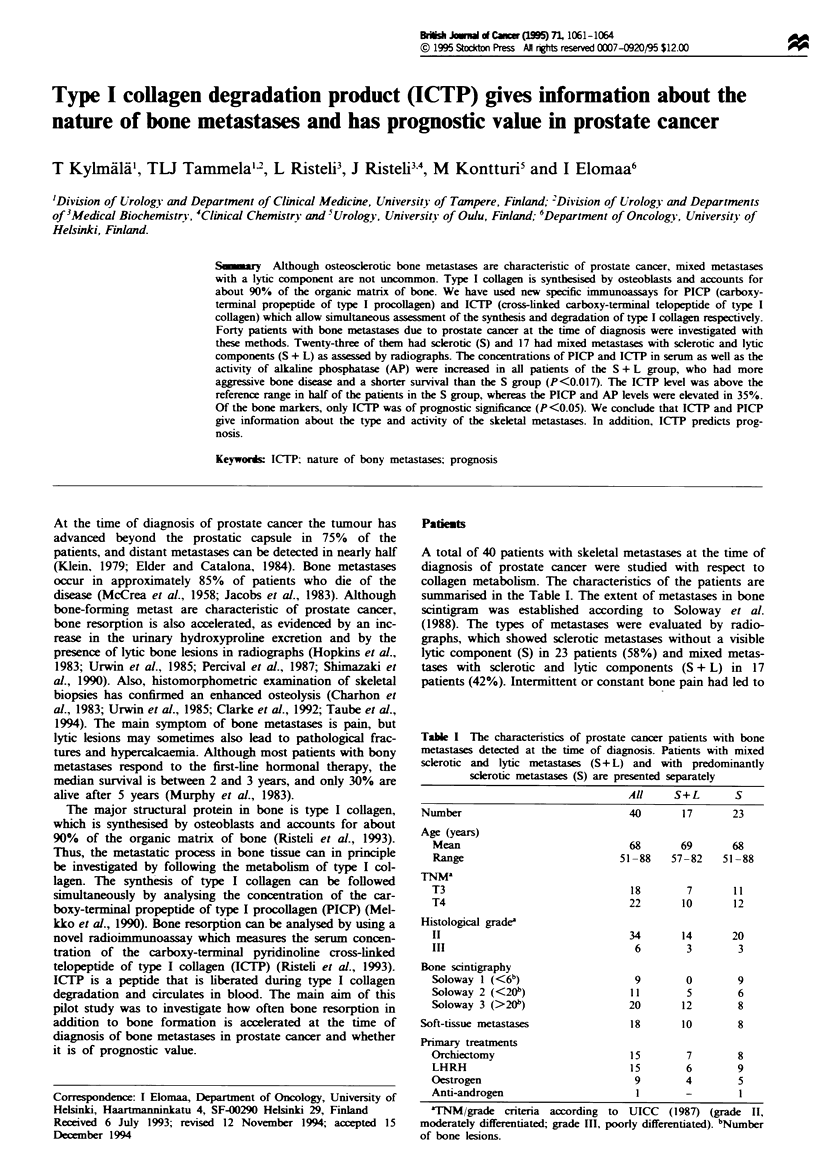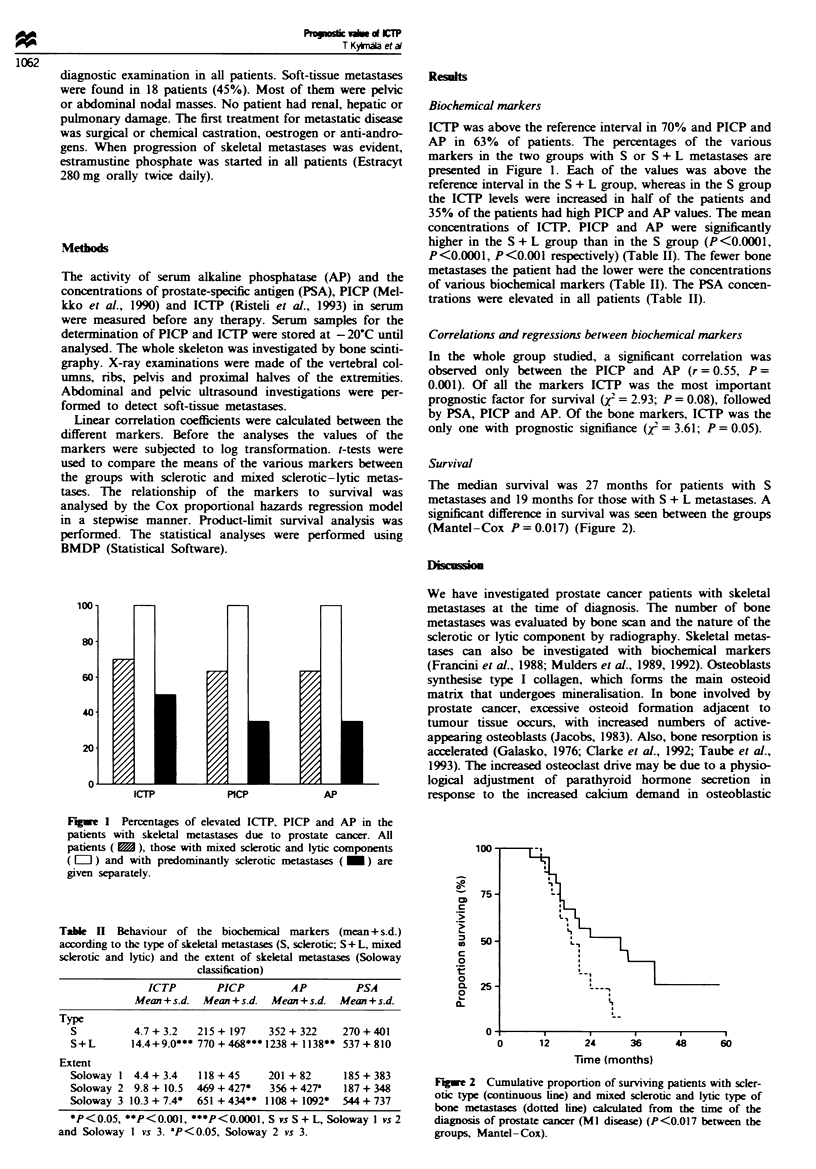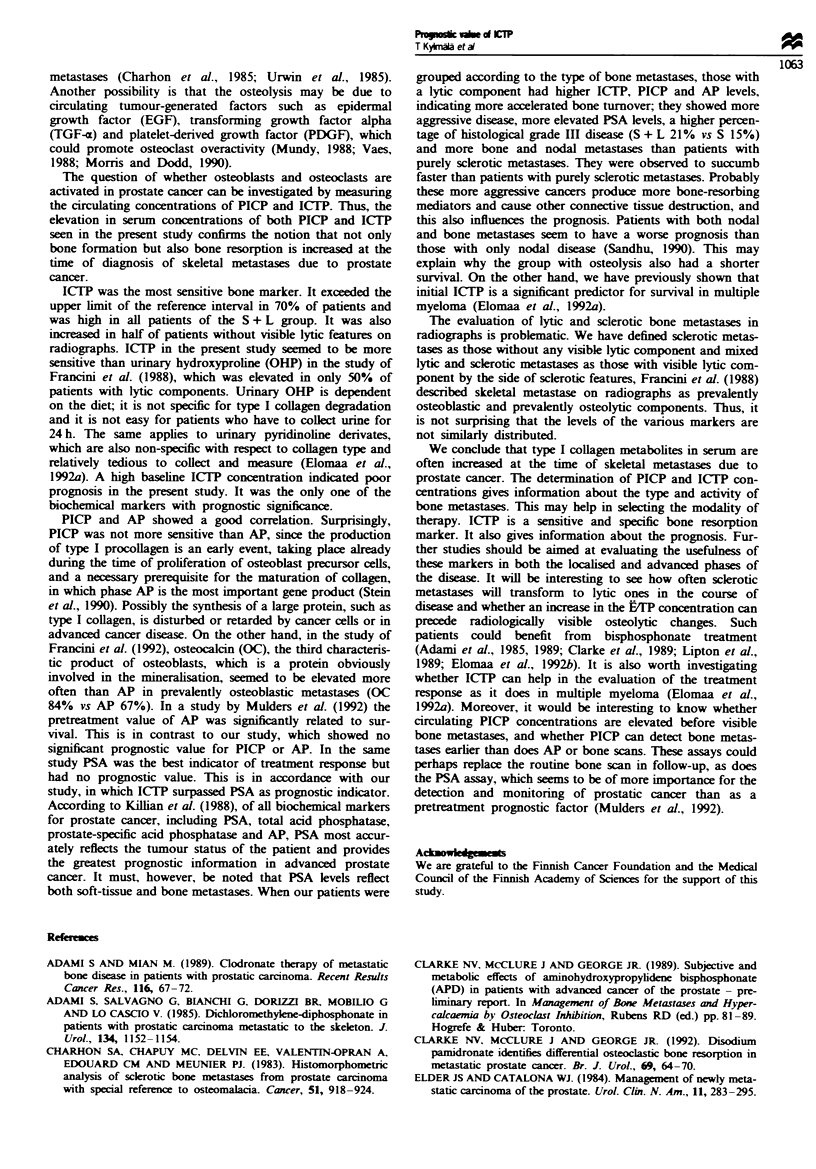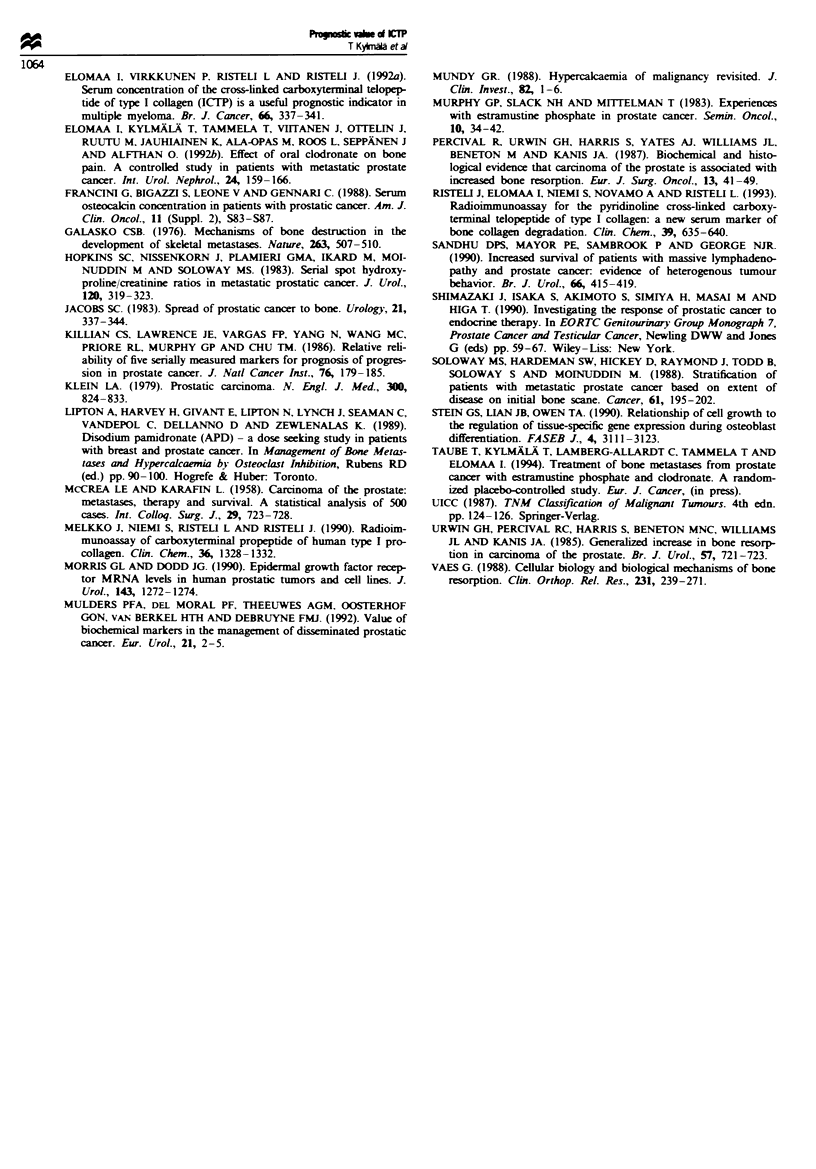Abstract
Although osteosclerotic bone metastases are characteristic of prostate cancer, mixed metastases with a lytic component are not uncommon. Type I collagen is synthesised by osteoblasts and accounts for about 90% of the organic matrix of bone. We have used new specific immunoassays for PICP (carboxy-terminal propeptide of type I procollagen) and ICTP (cross-linked carboxy-terminal telopeptide of type I collagen) which allow simultaneous assessment of the synthesis and degradation of type I collagen respectively. Forty patients with bone metastases due to prostate cancer at the time of diagnosis were investigated with these methods. Twenty-three of them had sclerotic (S) and 17 had mixed metastases with sclerotic and lytic components (S + L) as assessed by radiographs. The concentrations of PICP and ICTP in serum as well as the activity of alkaline phosphatase (AP) were increased in all patients of the S + L group, who had more aggressive bone disease and a shorter survival than the S group (P < 0.017). The ICTP level was above the reference range in half of the patients in the S group, whereas the PICP and AP levels were elevated in 35%. Of the bone markers, only ICTP was of prognostic significance (P < .05). We conclude that ICTP and PICP give information about the type and activity of the skeletal metastases. In addition, ICTP predicts prognosis.
Full text
PDF



Selected References
These references are in PubMed. This may not be the complete list of references from this article.
- Adami S., Mian M. Clodronate therapy of metastatic bone disease in patients with prostatic carcinoma. Recent Results Cancer Res. 1989;116:67–72. doi: 10.1007/978-3-642-83668-8_6. [DOI] [PubMed] [Google Scholar]
- Adami S., Salvagno G., Guarrera G., Bianchi G., Dorizzi R., Rosini S., Mobilio G., Lo Cascio V. Dichloromethylene-diphosphonate in patients with prostatic carcinoma metastatic to the skeleton. J Urol. 1985 Dec;134(6):1152–1154. doi: 10.1016/s0022-5347(17)47663-4. [DOI] [PubMed] [Google Scholar]
- Charhon S. A., Chapuy M. C., Delvin E. E., Valentin-Opran A., Edouard C. M., Meunier P. J. Histomorphometric analysis of sclerotic bone metastases from prostatic carcinoma special reference to osteomalacia. Cancer. 1983 Mar 1;51(5):918–924. doi: 10.1002/1097-0142(19830301)51:5<918::aid-cncr2820510526>3.0.co;2-j. [DOI] [PubMed] [Google Scholar]
- Clarke N. W., McClure J., George N. J. Disodium pamidronate identifies differential osteoclastic bone resorption in metastatic prostate cancer. Br J Urol. 1992 Jan;69(1):64–70. doi: 10.1111/j.1464-410x.1992.tb15461.x. [DOI] [PubMed] [Google Scholar]
- Elder J. S., Catalona W. J. Management of newly diagnosed metastatic carcinoma of the prostate. Urol Clin North Am. 1984 May;11(2):283–295. [PubMed] [Google Scholar]
- Elomaa I., Kylmälä T., Tammela T., Viitanen J., Ottelin J., Ruutu M., Jauhiainen K., Ala-Opas M., Roos L., Seppänen J. Effect of oral clodronate on bone pain. A controlled study in patients with metastic prostatic cancer. Int Urol Nephrol. 1992;24(2):159–166. doi: 10.1007/BF02549644. [DOI] [PubMed] [Google Scholar]
- Elomaa I., Virkkunen P., Risteli L., Risteli J. Serum concentration of the cross-linked carboxyterminal telopeptide of type I collagen (ICTP) is a useful prognostic indicator in multiple myeloma. Br J Cancer. 1992 Aug;66(2):337–341. doi: 10.1038/bjc.1992.266. [DOI] [PMC free article] [PubMed] [Google Scholar]
- Francini G., Bigazzi S., Leone V., Gennari C. Serum osteocalcin concentration in patients with prostatic cancer. Am J Clin Oncol. 1988;11 (Suppl 2):S83–S87. doi: 10.1097/00000421-198801102-00021. [DOI] [PubMed] [Google Scholar]
- Galasko C. S. Mechanisms of bone destruction in the development of skeletal metastases. Nature. 1976 Oct 7;263(5577):507–508. doi: 10.1038/263507a0. [DOI] [PubMed] [Google Scholar]
- Hopkins S. C., Nissenkorn I., Palmieri G. M., Ikard M., Moinuddin M., Soloway M. S. Serial spot hydroxyproline/creatinine ratios in metastatic prostatic cancer. J Urol. 1983 Feb;129(2):319–323. doi: 10.1016/s0022-5347(17)52076-5. [DOI] [PubMed] [Google Scholar]
- Jacobs S. C. Spread of prostatic cancer to bone. Urology. 1983 Apr;21(4):337–344. doi: 10.1016/0090-4295(83)90147-4. [DOI] [PubMed] [Google Scholar]
- Killian C. S., Emrich L. J., Vargas F. P., Yang N., Wang M. C., Priore R. L., Murphy G. P., Chu T. M. Relative reliability of five serially measured markers for prognosis of progression in prostate cancer. J Natl Cancer Inst. 1986 Feb;76(2):179–185. [PubMed] [Google Scholar]
- Klein L. A. Prostatic carcinoma. N Engl J Med. 1979 Apr 12;300(15):824–833. doi: 10.1056/NEJM197904123001504. [DOI] [PubMed] [Google Scholar]
- McCREA L. W., KARAFIN L. Carcinoma of the prostate: metastases, therapy and survival; a statistical analysis of five hundred cases. J Int Coll Surg. 1958 Jun;29(6):723–728. [PubMed] [Google Scholar]
- Melkko J., Niemi S., Risteli L., Risteli J. Radioimmunoassay of the carboxyterminal propeptide of human type I procollagen. Clin Chem. 1990 Jul;36(7):1328–1332. [PubMed] [Google Scholar]
- Morris G. L., Dodd J. G. Epidermal growth factor receptor mRNA levels in human prostatic tumors and cell lines. J Urol. 1990 Jun;143(6):1272–1274. doi: 10.1016/s0022-5347(17)40253-9. [DOI] [PubMed] [Google Scholar]
- Murphy G. P., Slack N. H., Mittelman A. Experiences with estramustine phosphate (Estracyt, Emcyt) in prostate cancer. Semin Oncol. 1983 Sep;10(3 Suppl 3):34–42. [PubMed] [Google Scholar]
- Percival R. C., Urwin G. H., Harris S., Yates A. J., Williams J. L., Beneton M., Kanis J. A. Biochemical and histological evidence that carcinoma of the prostate is associated with increased bone resorption. Eur J Surg Oncol. 1987 Feb;13(1):41–49. [PubMed] [Google Scholar]
- Risteli J., Elomaa I., Niemi S., Novamo A., Risteli L. Radioimmunoassay for the pyridinoline cross-linked carboxy-terminal telopeptide of type I collagen: a new serum marker of bone collagen degradation. Clin Chem. 1993 Apr;39(4):635–640. [PubMed] [Google Scholar]
- Sandhu D. P., Mayor P. E., Sambrook P., George N. J. Increased survival of patients with massive lymphadenopathy and prostate cancer: evidence of heterogeneous tumour behaviour. Br J Urol. 1990 Oct;66(4):415–419. doi: 10.1111/j.1464-410x.1990.tb14965.x. [DOI] [PubMed] [Google Scholar]
- Shimazaki J., Isaka S., Akimoto S., Sumiya H., Masai M., Higa T. Investigating the response of prostatic cancer to endocrine therapy. Prog Clin Biol Res. 1990;357:59–67. [PubMed] [Google Scholar]
- Soloway M. S., Hardeman S. W., Hickey D., Raymond J., Todd B., Soloway S., Moinuddin M. Stratification of patients with metastatic prostate cancer based on extent of disease on initial bone scan. Cancer. 1988 Jan 1;61(1):195–202. doi: 10.1002/1097-0142(19880101)61:1<195::aid-cncr2820610133>3.0.co;2-y. [DOI] [PubMed] [Google Scholar]
- Stein G. S., Lian J. B., Owen T. A. Relationship of cell growth to the regulation of tissue-specific gene expression during osteoblast differentiation. FASEB J. 1990 Oct;4(13):3111–3123. doi: 10.1096/fasebj.4.13.2210157. [DOI] [PubMed] [Google Scholar]
- Urwin G. H., Percival R. C., Harris S., Beneton M. N., Williams J. L., Kanis J. A. Generalised increase in bone resorption in carcinoma of the prostate. Br J Urol. 1985 Dec;57(6):721–723. doi: 10.1111/j.1464-410x.1985.tb07040.x. [DOI] [PubMed] [Google Scholar]
- Vaes G. Cellular biology and biochemical mechanism of bone resorption. A review of recent developments on the formation, activation, and mode of action of osteoclasts. Clin Orthop Relat Res. 1988 Jun;(231):239–271. [PubMed] [Google Scholar]


